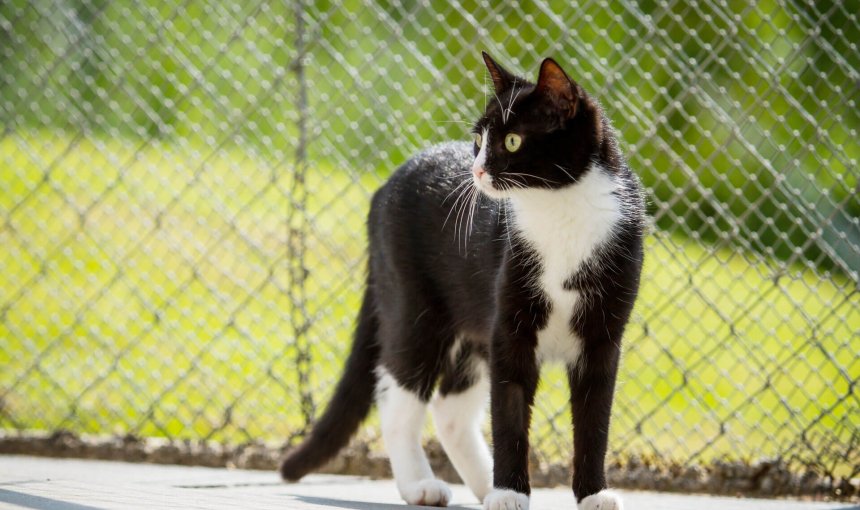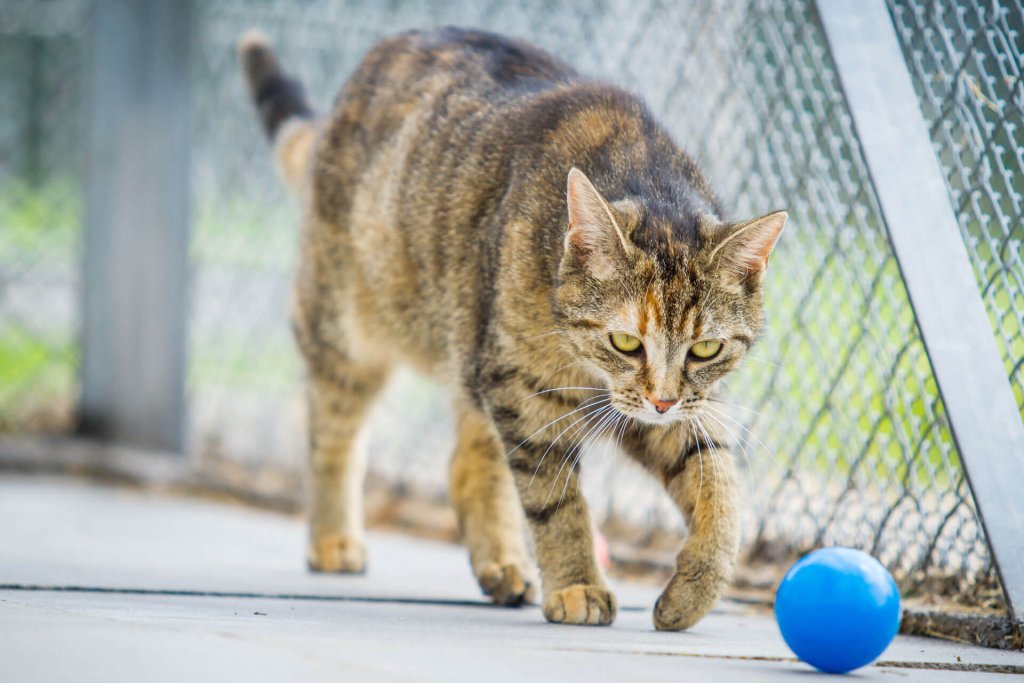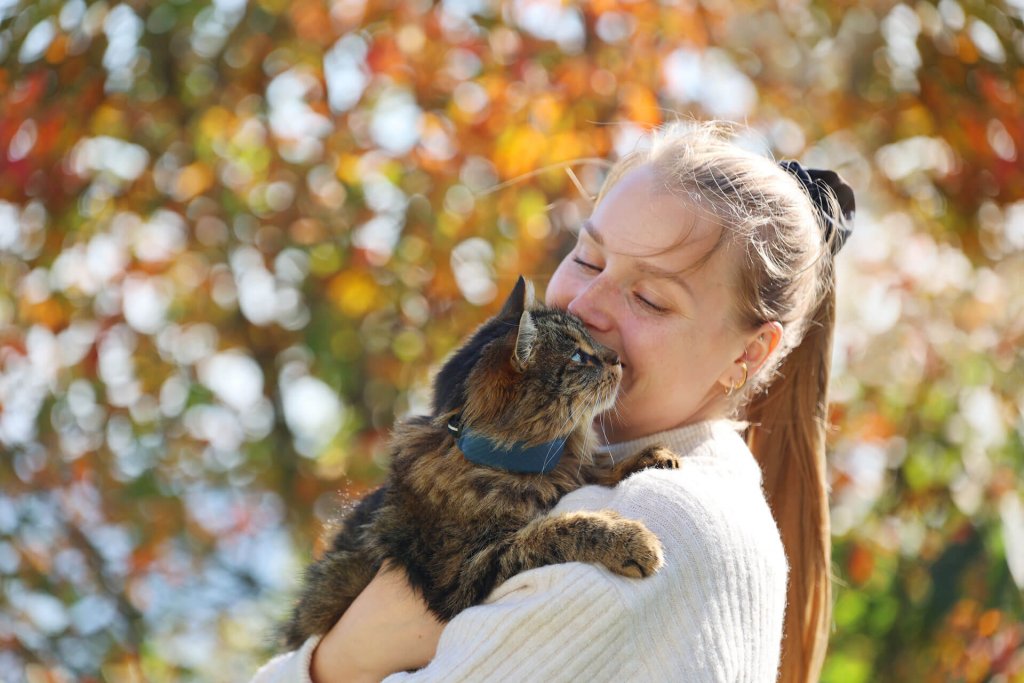Catio: What Makes The Perfect Outdoor Cat Enclosure For Your Cat
Give your pet cat the best of both worlds: an enclosed outdoor catio where they can enjoy nature while staying safe and close to home.

Is there a cat that doesn’t love snoozing in the sun, watching birds, and feeling the wind in their whiskers? Here’s a way for your indoor or outdoor cat to enjoy the enriching sights, sounds and smells of nature and still be protected. How? With an outdoor catio!
- What is a catio?
- Why build a catio?
- What are the benefits of a catio?
- Know everywhere your cat goes
- What are the different types of catios?
- How will your cat get in and out of the catio?
- Furnishings: What to put in your catio
- How will the catio be accessed by a human?
- What’s the best location for a catio?
- Can I leave my cat in the catio at night?
- What’s the best type of catio for a cat?
- Buy or DIY: Pros and cons
- How much do catios cost?
- What do I need for a DIY catio?
- How often will your catio be used?
- Will your cat ever want to leave the catio?
What is a catio?
A catio is an outdoor cat enclosure or “cat patio” that you build or buy to provide a safe outdoor space for your cat. Catios are a perfect solution that allows your cat to be outside while you enjoy peace of mind knowing that your kitty is always safe.
Why build a catio?
Cats love fresh air. But pet cats that roam freely outdoors are at higher risk of illness and injury. They could be hit by a car, attacked by a predator, or tussle with another roaming pet.
Catio enclosures allow your outdoor cat to continue enjoying the open air, but remain protected from the negative aspects of outdoor living. An indoor cat with access to an outdoor catio will live an enriched life in comfort and safety.
What are the benefits of a catio?
Maybe you live in a small apartment and can’t take your indoor cat on supervised walks. Perhaps you live in a rural area where predators roam and you don’t want to worry about your outdoor cat being injured or killed. Or, you want to enrich your indoor cat’s life by providing safe access to sunshine and breezes. An outdoor catio is the answer!
An outdoor catio enclosure can help alleviate boredom or stress in kitties who spend most of their time indoors. A catio can also be a way to separate cats who don’t get along, and may even improve the cats’ relationship by providing an outlet for pent-up energy.
By building an outdoor catio instead of letting your beloved pet cat roam outside, you are not being cruel – you are keeping your cat safe and healthy. And, you’ll have your fluffy friend around for many more years: studies show that indoor cats live longer than outdoor cats on average1.

Know everywhere your cat goes
See where they are in real-time, no matter how far they go. Get alerts if they roam too far home. Find out where they’ve been and discover their favorite spots. Let others track with you.
What are the different types of catios?
Catios can be very simple or quite elaborate. An outdoor catio enclosure can be built on your balcony, attached to a window, or be freestanding in your backyard. Catios can be constructed for free by using castoff or recycled materials. Alternatively, you can spend up to several thousand dollars for a deluxe catio kit. Building your catio cat house can be a quick weekend DYI project. Or, you can go all out design a multi-level catio palace for your kitties!
Window catio
A window catio hangs up against a first-floor window in your home. A window catio can be small or extend all the way to the ground. You can construct your own window catio from wood and wire, or hang a large dog crate up against the window. Be sure to add supports below so the structure is able to hold the weight of your cat without sagging.
The beauty of a window catio is that all you need to do is open your home’s window for your cat to enter their own personal outdoor room. Your pet can come back inside whenever they like.
Porch catio
Think of a porch catio as a miniature screened-in porch for your kitty. Construct it on your deck or patio, with the solid surface as the base. A porch catio can be any height. Make sure it includes an elevated perch or cat tree where your cat can get off the ground to survey their outdoor kingdom.
Balcony catio
If you live in an apartment, you can turn all or part of your balcony or fire escape into a catio. For a DIY option, zip-tie poultry fencing to the balcony’s railing, then add more poultry fencing on top to create an enclosure. Or, simply position a large dog crate on your balcony and place your kitty in it for long, lazy afternoon naps.
Be sure to leave space for yourself to enjoy the balcony or fire escape beside your cat. And of course, allow enough room to use the fire escape for its intended purpose in the event of an emergency.
Portable catios
A portable catio is a free-standing outdoor cat enclosure that sits in your yard and is not attached to your home. They can be moved to different locations in your yard, or disassembled and taken with you if you move to a new home.
The sky’s the limit for a portable outdoor catio! You can choose a pop-up tent with screened sides, a mesh cat playpen, a wire enclosure that sets on your lawn, or a multi-level wood-frame catio.
Portable wood-frame catio enclosure kits can be purchased online and include all the materials and hardware needed to assemble yourself. You can also buy detailed DIY catio plans and purchase the materials, then build the structure in your yard.
Think about adding a vestibule with a two-door “airlock”-style entrance to create an escape-proof entry and exit point to your free-standing outdoor portable catio enclosure.

Fencing for cats
You might be thinking, “I have a fenced yard – why don’t I just let my cat roam in the yard to give them outdoor time?” This sounds like a good idea until you discover that cats are expert climbers and can scale most fences. Also, cats are smaller and more agile than dogs and can slip through surprisingly narrow openings in your fence.
To successfully keep a cat in your fenced yard, you’ll need to cat-proof your fence. This requires adding an inward-slanting barrier on the interior side of your fence, close to the top. This barrier can be made of wire fencing mounted between sturdy poles, and must be strong enough to hold the full weight of your cat. If your cat climbs the fence and onto this inward-slanting barrier, they will end up hanging upside-down from the barrier. For most cats, this will prove to be a deterrent to escape. But, it’s always possible that a highly motivated and athletic kitty could find a way to get over the barrier! This is where a GPS cat tracker from Tractive can come in handy to find your missing cat.
Outdoor cat tunnels
An outdoor cat tunnel can be freestanding or attached to your home or outdoor catio. They give your cat room to stroll around and patrol their territory. Soft mesh-sided cat tunnels are around 10 feet long and can be placed anywhere in your yard. Just flatten the mesh tunnel and put it away when kitty is done playing.
Another option is to build a permanent outdoor cat tunnel from heavy wire, or create a wood frame and cover with sturdy window screening.
A screened-in porch
If you have an existing screened-in porch or three-season room attached to your house, you already have the perfect catio at your fingertips. (And your cat has probably already claimed it!) If you don’t have a screened-in porch, it’s really a perfect way for you and your cat to enjoy ultimate outdoor living in total safety and comfort. This is obviously an expensive undertaking, but it’s worth considering to make the whole family happy.
How will your cat get in and out of the catio?
When building your catio, think about how your kitty will safely access this cat-friendly amenity. Do you want your cat to have 24/7 access, or do you want to monitor their comings and goings?
Window access
Building your catio against a window is a simple way to let your cat into an outdoor catio. But you won’t want to leave your window open all the time. At night, or when temperatures drop, you’ll probably close the window. So kitty will have to stay inside at night.
Doggy-door flap
If your catio enclosure is up against your house at ground-level, add a doggy-door flap that your cat can use to enter the catio from the house. Cover the doggy-door if you don’t want your cat to sneak out to the catio at night.
Carried into the catio
A free-standing catio enclosure requires you to transport your cat from the house to the security of the outdoor catio. This could become a risky situation if your cat is uncooperative during the short walk to the catio. Having a two-door “airlock” on your free-standing portable catio can provide an extra layer of security as you go into and out of the catio.
If your cat should escape on the way to or from the catio, having a GPS cat tracker attached to their collar will make it easy to track them down. Just open the Tractive app on your smartphone and see your feline friend’s precise location.
Combination cat tunnel and doggy-door flap
A wood-and-wire outdoor cat tunnel is a great option for connecting a free-standing portable catio to your home. Position one end the cat tunnel against a doggy-door flap on the outside wall of your home, and place the other against the free-standing outdoor catio enclosure. This allows your kitty to go outdoors whenever they choose. Most doggy-doors have a cover that you can slide on at night, during severe weather, or whenever you want to keep your cat indoors.
Furnishings: What to put in your catio
Deciding what to put in your outdoor catio depends on the size of your catio and whether your cat can enter and exit at will. Your catio can be simple, with just a rug and water bowl. Another option is to add scratching posts and toys. If your catio is tall, add some shelves and a cat tree so kitty can perch up high. Provide a little shelter box in case of rain.
If the catio is large enough for you to enter, add a comfy chair so you can enjoy the catio with your furry companion. If kitty will be in the outdoor catio for extended periods, consider including a litter box. A planter of cat grass for munching is a nice touch for this cat house.
How will the catio be accessed by a human?
When designing your outdoor catio, remember that you, the cat’s human, will need to get into the catio, too – to fill water bowls, spruce up, clean the litter box, or deliver food – so make sure you can either reach into the catio enclosure or step inside through a large door. Create a comfortable access point for yourself so that maintaining your cat’s new favorite space is quick and easy.
What’s the best location for a catio?
Anyplace that your cat can be safely outdoors in a catio enclosure is a perfect location. If you have a few options on where to place your outdoor catio enclosure, consider these factors:
- Sunshine and shade: Cats love to bask in the sun, but they need shade for chilling out, too. So create a basking spot positioned to receive the morning sun, and build a little cubby or place a tarp over one corner of the catio’s roof to create a shady nook.
- The view: Any view of the outdoors will give your cat lots to look at all day long – birds, leaves blowing in the wind, little bugs flying by, or kids outside playing. If you can position your outdoor catio to maximize the view, your cat will appreciate it.
- Not too far from the house: You are your cat’s favorite human, so place your catio where you and your cat can interact during the day. If it’s too far from the house, you may not be able to keep an eye on your kitty.
Can I leave my cat in the catio at night?
Giving your cat overnight access to an outdoor catio depends on the catio’s location and your comfort level. If your catio is accessed through a doggy-door, decide if you want the doggy-door left open all night. Your cat may want to come back inside because of bad weather (or a sudden desire to sleep right next to your head).
The safest option is to bring your cat indoors at night. Many predators and outdoor cats roam at night, and your cat could become frightened or hassled by them while alone in the outdoor catio enclosure. Noises like fireworks can startle your cat and make them afraid of going back outdoors. And if unexpected storms roll in, you don’t want your kitty to face that alone. Safeguarding your cat should always be a priority.

What’s the best type of catio for a cat?
The best type of catio is one that your kitty will use and that you can afford. Test out some simple cat enclosure options before investing hundreds of dollars on a catio. If your indoor cat has never spent time outside, borrow a friend’s dog crate and see how your pet cat reacts to being outdoors.
If the catio you select gives your cat the option to enter and leave at will (rather than being locked out) your cat may feel more at home and relaxed in this new, enriching outdoor space.
Buy or DIY: Pros and cons
- DIY Catio – Pros: On the plus side, you can customize a DIY catio enclosure to meet your cat’s specific needs. Also, you can securely attach the catio to your window, patio, or other structure by building it yourself. A DIY catio will probably cost less than a ready-made catio or catio kit, and detailed DIY catio plans can be downloaded for free or purchased inexpensively online.
- DIY Catio – Cons: The downside of a DIY catio is that…well, you have to build it. You’ll need at least a tiny bit of construction know-how and some basic tools. If this is not you, enlist the help of a handy friend! A DIY project can also take longer and require more planning than buying a catio kit.
- Buy a Catio – Pros: Buying a catio enclosure kit means that all the lumber, screening, and hardware is included. You’ll still need a few basic tools and be able to understand the instructions, but you can probably complete the project in half a day.
- Buy a Catio – Cons: You’ll most likely spend more on an outdoor catio kit than building it yourself. Also, you have limited options for customizing a catio kit.
How much do catios cost?
Pre-assembled outdoor catios or cat patio kits can cost anywhere from $200 to thousands of dollars. On the other hand, a DIY catio enclosure can be made for far less. You may even be able to repurpose scrap wood, screening, or an old dog crate and build your DIY catio at no cost!
What do I need for a DIY catio?
To build your own DIY catio, you’ll need:
- A plan: download free catio plans or purchase one online, or sketch out your idea in advance.
- Tools: A measuring tape, saw, hammer, drill, wire cutters, and screws.
- Materials: Wood boards of various sizes, depending on the dimensions of your catio; and wire (such as poultry fencing) or sturdy screening. You’ll need to calculate how much you need depending on the catio’s size (hence the need to sketch out a plan in advance!).
Depending on your skills and complexity of the project, you might spend a half-day or an entire weekend building your DIY catio. But your feline friend will thank you.
How often will your catio be used?
If your cat is like most kitties, your outdoor catio enclosure will be used every day, even in winter. Most cats can tolerate cool or even cold days, especially if they can acclimate to the changes in weather gradually. And what cat can resist a sun puddle on a chilly morning?
Will your cat ever want to leave the catio?
Maybe not! An outdoor catio enclosure, whether big or small, simple or elaborate, may become your cat’s new favorite place. In fact, you may have a hard time getting your furry companion to leave the catio!
By building an outdoor catio enclosure, you will enrich the life of your indoor cat and keep your outdoor cat safe and healthy. The sights, sounds, and smells of nature will stimulate, comfort, and soothe your kitty as they snooze in sun puddles in their new outdoor catio.
Need some more inspiration for your cat patio? Then checkout these cute cat-ios enjoying their outdoor abode!
P.S. Does your cat need a heated cat house?
Like this post? Share it with another cat lover today!




